Which of the following will form tri-bromo derivative of phenol ?

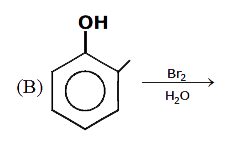
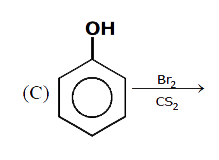
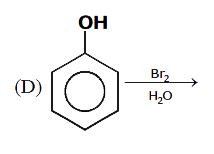
The correct Answer is:D
To determine which of the given compounds will form a tri-bromo derivative of phenol, we need to analyze the effects of substituents on the phenol ring and how they influence electrophilic aromatic substitution reactions.
1. Identify the Substituents on Phenol:
- We have phenol as our base compound. The substituents can either be activating or deactivating groups, and they can also be ortho/para-directing or meta-directing.
2. Analyze the First Option:
- The first option has a methyl group (–CH₃) attached to phenol. Both the –OH (hydroxyl) and –CH₃ groups are ortho/para-directing and activating groups.
- However, the ortho position of the methyl group blocks the para position of the hydroxyl group, making it impossible for bromine to substitute at the para position.
- Therefore, this option will not lead to a tri-bromo derivative.
3. Analyze the Second Option:
- The second option also has a methyl group on the ortho position relative to the hydroxyl group.
- Similar to the first option, the ortho position of the methyl group blocks the para position of the hydroxyl group, preventing substitution at both ortho and para positions.
- Thus, this option will also not form a tri-bromo derivative.
4. Analyze the Third Option:
- The third option involves phenol reacting with Br₂ in a non-polar solvent (CS₂).
- In this case, phenol can yield mono-bromo derivatives (ortho and para) but not tri-bromo derivatives, as the solvent does not ionize phenol to form phenoxide ions.
5. Analyze the Fourth Option:
- The fourth option involves phenol reacting with Br₂ in an aqueous solution.
- In this scenario, phenol ionizes to form phenoxide ions, which significantly increases the electron density on the ring, allowing for multiple substitutions.
- The presence of water as a solvent leads to the formation of a tri-bromo derivative (246-tribromophenol) due to the enhanced reactivity of the phenoxide ion.
Conclusion:
The compound that will form a tri-bromo derivative of phenol is the one reacting in an aqueous solution, leading to the formation of phenoxide ions, which activate the ring for multiple substitutions.
- We have phenol as our base compound. The substituents can either be activating or deactivating groups, and they can also be ortho/para-directing or meta-directing.
- The first option has a methyl group (–CH₃) attached to phenol. Both the –OH (hydroxyl) and –CH₃ groups are ortho/para-directing and activating groups.
- However, the ortho position of the methyl group blocks the para position of the hydroxyl group, making it impossible for bromine to substitute at the para position.
- Therefore, this option will not lead to a tri-bromo derivative.
- The second option also has a methyl group on the ortho position relative to the hydroxyl group.
- Similar to the first option, the ortho position of the methyl group blocks the para position of the hydroxyl group, preventing substitution at both ortho and para positions.
- Thus, this option will also not form a tri-bromo derivative.
- The third option involves phenol reacting with Br₂ in a non-polar solvent (CS₂).
- In this case, phenol can yield mono-bromo derivatives (ortho and para) but not tri-bromo derivatives, as the solvent does not ionize phenol to form phenoxide ions.
- The fourth option involves phenol reacting with Br₂ in an aqueous solution.
- In this scenario, phenol ionizes to form phenoxide ions, which significantly increases the electron density on the ring, allowing for multiple substitutions.
- The presence of water as a solvent leads to the formation of a tri-bromo derivative (246-tribromophenol) due to the enhanced reactivity of the phenoxide ion.
The compound that will form a tri-bromo derivative of phenol is the one reacting in an aqueous solution, leading to the formation of phenoxide ions, which activate the ring for multiple substitutions.
Topper's Solved these Questions
- BOOK - MOTIONCHAPTER - AROMATIC COMPOUNDEXERCISE - Exercise - 2 (Level-I)47videos
AROMATIC COMPOUND
- BOOK - MOTIONCHAPTER - AROMATIC COMPOUNDEXERCISE - Exercise - 2 (Level-II)29videos
AROMATIC COMPOUND
- BOOK - MOTIONCHAPTER - ALKYI HALIDEEXERCISE - Exercise - 4 | Level-II8videos
ALKYI HALIDE
- BOOK - MOTIONCHAPTER - ATOMIC STRUCTURE EXERCISE - EXERCISE-4 (LEVEL-II)18videos
ATOMIC STRUCTURE
Similar Questions
Knowledge Check
- Question 1 - Select One
Which of following will form tri-bromo derivative of phenol ?
A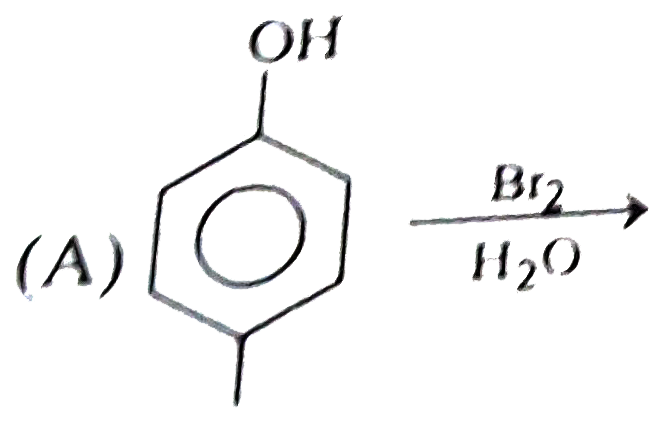 B
B C
C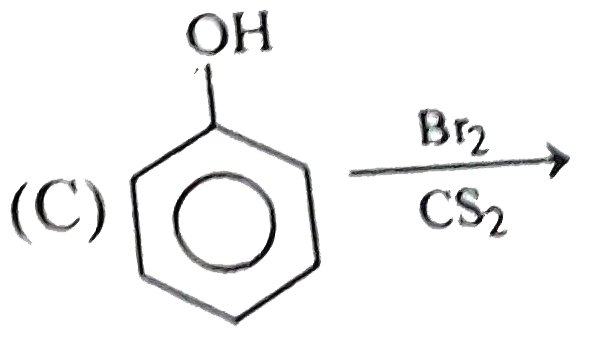 D
D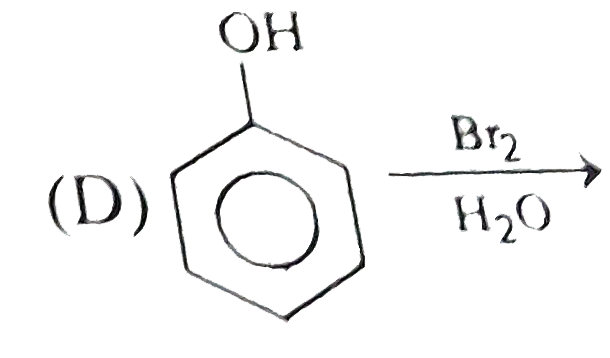
- Question 2 - Select One
Which of the following is phenol ?
ACresolBCatecholCBenzenolDAll of these - Question 3 - Select One
Which of these compounds will not form tribromo derivative ?
AAnisoleBPhenolCO-cresolDSalicylic acid
The reaction of bromine with which of the following phenols shall produce tribromo derivative ?
View SolutionWhich of the following can forms metallic derivatives by replacement of H-atoms?
View SolutionWhich of following is phenolic?
View SolutionWhich of the following is a trihydric phenol ?
View SolutionWhich of the following will increase the acidity of phenol ?
View Solution

